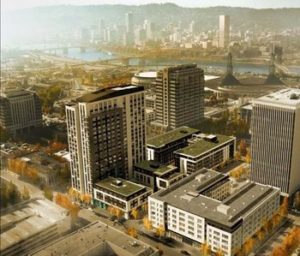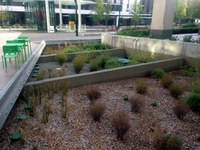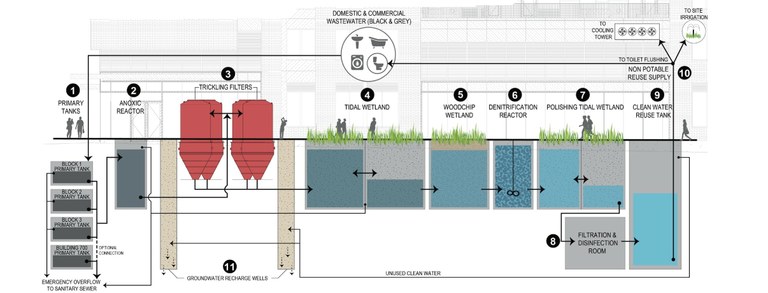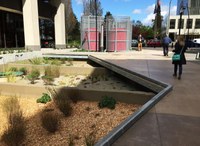Human Waste Treatment and Water Reuse at Hassalo on Eighth
Case Study: Published | Updated: | | Oregon, Portland |- Category
- category_listing(s)
- Building Type
- Multifamily
- Innovation
- Natural Organic Recycling Machine
- Jurisdiction
- Oregon, Portland
- Parcel
- Officials
- Matt Kohlbecker | Oregon Dept. of Environmental Quality
- Team
-
Sarah Tipsord
|
owner
Kyle Andersen | Designer
Pete Munoz | Environmental Engineer
Pat Lando | Landscape Architect
Matt Kohlbecker | approving-official
Molly Winter | Assigned Researcher
- Ratings & Awards
-
2016 Project of the Year Award
Portland Business Journal Seeking LEED Platinum Certification

American Assets Trust developed this mixed-use three-building project that spans four blocks as part of Portland’s Lloyd EcoDistrict. The three buildings share one of the largest natural organic recycling treatment systems in the US, which treats all the buildings’ wastewater (including human waste from toilets) for reuse for toilet flushing, mechanical cooling and below surface landscape irrigation in an urban setting. It was permitted as a Water Pollution Control Facility with two on-site injection dry wells. The project showcases the economic and ecological benefits of district scale onsite wastewater treatment and reuse.
To treat all three buildings wastewater on-site, Hassalo on 8th relies on a high-tech, low energy system developed by BioHabitats, an environmental engineering firm focusing on regenerative design. Their design is called the Natural Organic Recycling Machine, and affectionately nicknamed “NORM.” NORM is a permitted as a Water Pollution Control Facility (WPCF), regulated by the Oregon Department of Environmental Quality (DEQ). Before water can be injected into dry wells that will eventually filter through layers of earth into groundwater, it must be treated to Class A water quality standards as specified in ORS 468B.195 and OAR 340-044 which also govern the construction, operation, permitting, and closure of injection devices.
The owner and developer, American Assets Trust, has contracted Puttman Infrastructure to manage the monitoring and maintenance required for the WPCF permit. The buildings are required to be connected to the Portland sewer system to provide a backup in case there is a need for overflow capacity or potential problem with the system. The water is treated to Class A reuse standards so that it can be used for toilet flushing, cooling mechanical systems and irrigating the landscape.
| Code Requirement | Compliance Path |
|---|---|
| City of Portland: 17.33.030 Sewer Connection Mandated. Requires connection to City Sewer for overflow drainage. | Sewer connection permitted and installed. |
|
Oregon State: ORS 468B.195and OAR 340-044 adopting 40 CFR Parts 144, 145 and 146, implementing the Federal Safe Drinking Water Act requirements for Underground Injection Control. |
To permit the two on-site injection wells, to be placed within the footprint of the structure, an administrative building code appeal was required, and a full-time certified operator must conduct daily monitoring and performance testing. See Final Findings and Decision by the Design Commission 2013 |


